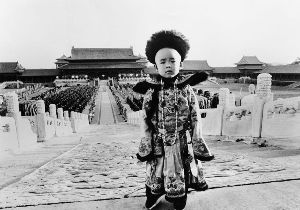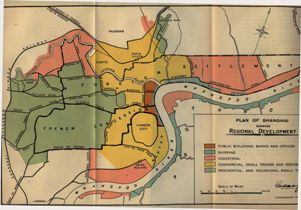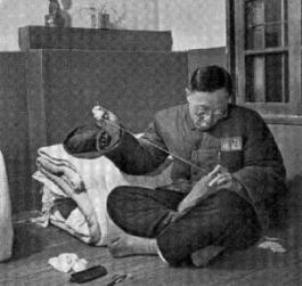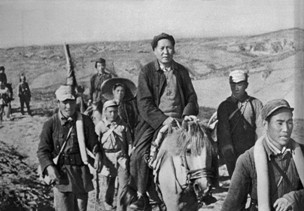
By Trailokya Jena
Defeats in Opium Wars in quick succession we discussed in Part-I led Chinese solar system to collapse as the Sun, mythically represented by its Emperor, went into long eclipse. Simultaneous burdens of major internal strains and continued Western imperialist pressure, whose military might it couldn’t match, China’s extravagant self image and position in the world got shattered from world’s leading civilization to a subjected and torn country. At this point in the mid nineteenth century its neighbour Japan was also forced open by Western powers. The contrasting approach of Japan to their humiliation to China’s would explain what was and continued to be wrong with Imperial China. Commodore Perry’s gunboats forced open Japan in 1853 as it had to undergo China’s experience with Western military power. Though Japan was suffering similar socio political decay as China, it undertook massive internal reforms and was able to adapt rapidly to match the power of the West and even established itself as a competitor with the Western powers for colonial rights in Asia. In 1894-5, Japan challenged and defeated China in a war over influence in Korea, thereby upsetting the traditional international order in East Asia, where China was the supreme and Japan a tribute-bearing subordinate power. Japan then went on to defeat Russia in 1904-05 to record the first ever victory over European nation by a non European. Soon after Japan steadily squeezed into mainland and eventually occupied parts of China leaving considerable bearings on Chinese history as we’ll come to later.
Defeat in Opium Wars was just the beginning of prolonged period of Chinese humiliation whose complex aftermath led to Chinese Nationalism germinated out of imperialism and anti-imperialism from 1850s to blossom with the victory of Communists in 1949. Signing of the Treaty of Nanjing, started a scramble for China to climax in the last quarter of 19th century. European colonial powers like Britain, France, Germany, Portugal and Belgium along with US, Japan and neighbouring Russia grabbed extensive tracts of Chinese territory. Japan even fought and defeated Russia for control over parts of Manchuria. Where they did not have territorial control, foreign powers claimed “spheres of influence” with control over their commercial and strategic interests. These were called “concessions” (in Chinese called Zujie means leased areas) on which Chinese sovereignty was a mere fiction as to all practical purposes those were permanently alienated colonies. The grant of many concessions to foreigners made it look as the whole world had come to squat on Chines coasts. People resented it as these concessions were granted under duress. To make matters worse, a concept of extraterritoriality came to be enjoyed by citizens of foreign powers as they were not subjected to Chinese law but to the jurisdictions of their Consulates. Foreign courts sat in China and foreign jails got built there.
Though Qings precariously held on to their country- China’s existence had not been extinguished like India’s- most people thought Qing’s weakness and incompetence in being unable to limit foreigners’ powers imperilled China. However, challenge came to Qings first from internal sources through Taiping Rebellion (1856-64) as natives disapproved heightened Christian missionaries activities threatening Chinese Confucian values by promoting individualism and technology. The rebellion, long and bloody, sought to oust the Manchu rulers and restore China to her past greatness, a sort of make China great again! When rebellion was finally quelled through British and French help, 20 million were dead. China was again made to sign unequal treaties while foreigners consolidated their position. The defeat of China by Japan in 1895, where China had to concede independence of Korea, resulted in deep embarrassment of Qing dynasty leading to calls for reforms for adopting European military technology and education system for self-strengthening of China considering how well that worked for Japan. But, the conservative traditionalists opted instead for old Confucian values blaming their Christian converts as traitors. This resulted in a fresh rebellion led by member of neighbourhood boxing clubs whose secret society Yihequan(Righteous and Harmonious Fists,the symbol of today’s aggressive Chinese closed fist) . Known as Boxer Rebellion(1900). it attempted to drive out all foreigners from China. It was later claimed as a nationalist movement whose course ran much like India’s first war of independence in 1857. The Boxers aligned with farmers achieved initial success but were ultimately defeated by coalition of foreign forces drawn from all countries having physical presence in China. Defeated yet again China had to sign the Boxer Protocol in1901 having to pay huge reparation, to grant much larger concessions and getting restrained from importing arms. Such punishing conditions finally served as the last nail on Qing dynasty coffin.

The aftermath of the failed Boxer Rebellion finally convinced the Chinese to modernise China economically, politically and technologically for which it was essential to overthrow the Imperial rule. Inside the Army it was realised that without thorough modernisation like Japan’s it was impossible to stand up to foreign powers, something not possible under the Qing rulers. Millions of Chinese living overseas, especially in Southeast Asia and the Americas, began pressing for either widespread reform or outright revolution. Kang Youwei and Liang Qichao emerged as leaders of those proposing the creation of a constitutional monarchy. Dozens of resistance groups came together under Sun Yat-sen, a nationalist with socialist tendencies, who led the amalgam of groups that together formed the Revolutionary Alliance or Tongmenghui for replacing Qing rule with a republican government. In October 1911, an incident in Wuchang (coincidentally now Wuhan the corona city) triggered an uprising which quickly spread to many provinces while Sun Yat-Sen was away in America raising fund for the revolution. Without going into the details of the romance and chaos of the revolutionary fighting the royal forces, we can go straight to the establishment of the revolutionary republic in Nanjing while mother of the last child emperor Pu Yi hung on in Forbidden Palace negotiating for a constitutional monarchy involving ex army General Yuan Shikai. While this dual rule was going on China fell into utter chaos of old pattern widespread war lordship in absence of strong central rule. Shikai was too shrewd with eyes on Presidentship and made Pu Yi abdicate himself assuming the role of President in Peking. Though events stabilised subsequently with the death of Shikai, the death of Sun Yat-Sen and establishment of Chines Communist Party by Mao whose strategy to seize power from what he called the bourgeois democratic government of Chiang Kaisek brought a decisive phase to Chinese history which would need detail examination.
With the abdication of Pu Yi, the six year old child known in history as the Last Emperor, the curtain fell on thousands of years dynasty rule in China. Power finally went back to the Han people who always claimed the true legacy over China. End of dynasty meant there would be no danger from outsiders like Mongols or Manchus ruling the overwhelming majority of Hans. An example was made out of the child Manchu ruler Pu Yi whose life story is told by the two photographs, one of the six year old Pu as Emperor and the other of 50 years old Pu stitching clothes to live life of a commoner under the strict vigil of Mao’s system we’ll come to later. The haunting tragedy of the life of Pu Yi is poignantly captured by Bernardo Bertolucci (maker of Last Tango in Paris) in his 1987 magnum opus The Last Emperor based on the 1964 autobiography of Pu Yi. It’s the best historical film and biopic one can ever see and highly recommended for watching during these corona times. Bertolucci’s closing sequence, using creative licence of a filmmaker, with Pu Yi working as security guard at the Palace he was once owner of is as shattering as they come in any performing art. In one sweep of the camera Bertolucci depicts the end of ancient empire and consolidation of another under Mao’s Communists which we’ll come to next. It will also continue our pattern of viewing China’s history from the perspective of dynasty and emperors for hereafter China could easily be understood through four real life Emperors, from Sun Yat-sen to Mao Zedong to Deng Xiaoping and finally Xi Jinping with Chiang Kai-sek missing out for obvious reasons.

Sun Yat-Sen(1866-1925) is acknowledged as the founding father of modern China, that rare Chinese leader revered by both nationalists and communists and respected in both China and Taiwan. He is accepted by both Chinas as the father of the nation and a great nationalist. The CPC regards him as a forerunner of the Revolution while Taiwan China sees him as founder of democratic socialism. His Three Principles-to make China a free, prosperous and powerful State- are fully accepted by the CCP till date. Without his unifying effort to bring all revolutionary factions together China couldn’t have become a Republic in 1912. However, his death in 1925 at the height of warlordism and initial days of CPC couldn’t prevent China from entering into a prolonged civil war for quarter of a century. He occupies the position of Emperor more in Chinese national spirit and socio cultural landscape than in political psyche.
The politics and psyche of modern China belong mostly to Mao Zedung(1893-1976). Perhaps no one ever enjoyed such complete sway over a nation, its people and the entire way of life of a society as Mao over China. The life and times of Mao is such that it’d perhaps be longer and deeper than the entire history of many countries. Its sheer magnitude is formidable enough to bring into our perspective here. Hence, I shall touch upon only those aspects having bearings on other States, especially India. Mao was among the founder members of CPC that was established in 1921 at a meeting held in French Concession areas of Shanghai. Initially supportive of KMT’s nationalist government the CPC came to conflict with Chiang Kai-sek whose suspicion of leftists led to a bloody purge of Communists and labour unionists in Shanghai shootings of 1927. From this time onwards the Nationalists and Communists became enemies. Mao’s first major engagement with KMT was in a peasant uprising in Hunan where Mao’s Chinese Workers and Peasants Party(later converted to Red Army), was routed and driven to the countryside by the nationalists. Thereafter Mao had to carry on a prolonged guerrilla war mainly in the countryside of the south Jiangxi province. In 1934 the nationalist army got them completely surrounded but somehow Mao with his supporters broke through the encirclement and escaped to west and then to north in three groups on a 6000 miles trek to far away Shaanxi Province. In an epic journey through most arduous terrain only 8000 survived out of 100,000 bearing hunger, disease and harassment by local tribes and hostile warlords. After a year long trek the groups united in Shaanxi in 1935 which was outside the direct control of the Nationalists. This epic journey entered the Chinese Communist mythology as the famous Long March creating folklores around Mao.

Everything about Mao was gigantic in scale, very long term in strategy, extremely unorthodox in ideas, most brutal in execution and far reaching in consequences. His understanding of Chinese people and their history was uniquely incisive. He was quick to realise that for China, westernisation of personal and political freedom, in a huge country with massive numbers of low income and poorly educated people, high levels of corruption and a weak civil society, would certainly spell chaos. He also realised that many traditional Chinese values were barriers to modernity and progress, hence to be abandoned. His long march through the vast terrains of countryside convinced him to redress the imbalance between rural China and its westernised urban worlds. He understood China’s needs for food, for industry, for education and for health to attain progress and get her position restored on world stage. He was bold, fearless, impatient and brooked no opposition. Some of his actions were epic in concept and scale, sometimes too impractical to execute at the time. But Mao was determined and ruthless and very impatient to push his programmes at immense cost to Chinese people and society just because he wanted to catch up with the world quickly. The human cost of his Great Leap Forward through agricultural revolution, technology revolution and finally cultural revolution was immense. He ran the country with complete authority as a modern manager runs a Football Club, deciding strategy, creating tactics, acquiring and discarding players, unlearning the past and learning the contemporary and the future. At times he also ran his country like a ruthless mobster challenging established orders and taking huge risks. When General Mac Arthur was prevented by China to reclaim whole of Korea he wanted China to be nuked. Reportedly Mao was reckless enough to react stating China could afford to lose some millions of people! While Mao succeeded in blocking America it was Mac Arthur who got fired by Truman. At another time, he could have been a Genghis Khan or Timur Lane. His concept and ruthless execution of the Cultural Revolution in 1960s at unprecedented human cost has few parallel in history. Impatient with the slow progress of Chinese development he identified the four impediments as the famous Four Olds: old customs, old culture, old habits and old ideas, all of which had to go. Reacting to anti cultural revolution remarks he reportedly said ‘ If we want to preserve our national characteristics, we must make sure that they can preserve us’.
Mao had enormous impact on India’s fate too which demands inevitable comparison with his great contemporary Nehru. While Nehru had discovered the heritage of India in his own way in the book ‘Discovery of India’, he was perhaps not as aware of India’s geography as Mao was China’s. Keen sense of geography made Mao realise the immediate need to contain India and Japan for China’s future. Like a classic mob boss Mao created and nurtured hit men on both flanks, Pakistan and North Korea, who still go on threatening respective neighbourhoods to carry out China’s contracts. His keen understanding of geography led him to control Tibet instantly as the entire civilisation of China has been dependent on water from two rivers, Yellow and Yangtze, both originating in Tibet while we didn’t realise in time Brahmaputra’s originating there too. While Nehru was feted by the world as the post-colonial poster boy, Mao was bidding his time to cut Nehru to size. There match up in history was like that between a rugged boy from tough neighbourhood meeting a polished boarding school produced aristocrat squaring up to each other on campus, a sight many of us would remember from our college days. When the two squared up on international ring the result had an inevitability written all over it. While Nehru couldn’t recover from the shock Mao went on to execute his Cultural Revolution. Though considerably declining towards his end, Mao received ultimate validation in history when America came calling on him to announce the restoration of China to the high table of nations. ‘Power grows out the barrel of a gun’, nothing would be truer than this quote from Mao.
Much of the present posturing of our social media warriors owes to Mao’s punching us hard on the face in 1962 from which we are yet to recover. At least I still carry that scar in memory which my 7 years’ mind couldn’t fathom as to how our great India and revered Nehru could suffer such hard punches. It took me a long time and hard education in history of international engagements to understand how a rag tag Army can stun and immobilise a much superior force. Winning wars, as taught from westerners’ history in school, is learnt on the playing field of Eton, or Harrow in case of Nehru, but the hard reality of modern world is substantially different. The Long March in heart of China is a far superior learning ground than the playing fields of either Eton or Harrow! Comparing Nehru and Mao is a highly contentious topic in present day India as any hint of hard appraisal of Nehru would immediately attract the wrath of the cousin hood of Liberals, Communists and Congressis inevitably leading to social media war with the brotherhood of Bhakts. Much that I may try to remain equidistant from both, it is very hard to avoid getting into the root cause of our present turmoil vis a vis China and staying out of the long shadows of Mao and Nehru.
(Jena, the former principal chief commissioner of Income Tax is yet to conclude the series)





